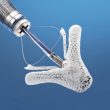One of the challenges that transcatheter aortic valve replacement (TAVR) continues to face is percutaneous access closure with percutaneous closure systems (PCS). However, several systems have been developed, either by plug—such as the MANTA system—or by suture (SU)—such as the ProStar and ProGlide systems. Both of these have been tested in different analyses, but to...
Prosthesis Mismatch in TAVR: It’s Real Impact
Prosthesis-patient mismatch (PPM) was initially proposed by Rahimtoola and reintroduced by Pirabot. PPM is the indexed effective orifice area in relation to body surface area, cutoff value being 0.85 cm2/m2, and <0.70 cm2/m2for obese patients. PPM is considered moderate if indexed effective orifice area is 0.65-0.85 cm2/m2 and severe when <0.65 cm2/m2 Research studies on surgical prosthesis have...
MitraScore: What Does the Final Result of Edge-to-Edge Treatment of Mitral Regurgitation Provide?
Edge-to-edge treatment has proven to be a safe and effective technique in follow-up, decreasing mortality and hospitalizations for heart failure when a good result is achieved. The MitraScore was developed to assess the outcome at the end of the procedure. In that sense, results <3 represent mild mitral regurgitation, which would be related to lower...
Amyloidosis and TAVR: Does this Disease Have an Impact?
Amyloidosis is a systemic disease that affects different organs and impairs their function. Recent studies with magnetic resonance imaging (MRI) have shown that between 13% and 16% of patients who undergo transcatheter aortic valve replacement (TAVR) have amyloidosis. A review of four studies showed that mortality at 20 months was twice as high when amyloidosis...
When Is It Best to Fracture a Bioprosthesis in TAVR?
At present, surgical aortic valve replacement (SAVR) uses bioprostheses. However, when these fail, we are presented with a great challenge, seeing as repeat SAVR involves a higher risk. In this context, valve-in-valve (V-in-V TAVR) has surged as a very attractive alternative. Bioprosthesis fracture (BPF) is a new interesting strategy that has shown lower gradient and...
Left Main Coronary Artery Revascularization: Are Periprocedural Complications Significant?
In the field of percutaneous coronary intervention (PCI) and myocardial revascularization surgery (MRS), previous analyses have shown a link between in-hospital and 30-day complications, in terms of complicated progress and/or mortality. Most of this information comes from non-randomized or old studies, which translates into contradictory data. Researchers analyzed the EXCEL study, which included patients with...
TriClip: Tricuspid Regurgitation Dedicated Device
Severe tricuspid regurgitation (TR) is difficult to manage and is associated to high morbimortality. Surgical repair is complex and not free from complications: its mortality rate ranges from 5 to 20% and depends on series, surgeon and center expertise. Edge-to-edge repair with clips has become a valid alternative to treat this disease, but most data...
COAPT: Promising 5-Year Outcomes
Secondary ischemic and non-ischemic mitral valve failure (SMR), produce left ventricle dilation, papillary muscle displacement, and impaired leaflet closure causing regurgitation. This will lead to ventricular function deterioration and bad prognosis. Edge-to-edge mitral valve repair with MitraClip has been shown safe and effective to treat SMR in the short term, but its evolution at 5...
TAVR: Vascular Access in Patients with Peripheral Artery Disease, 1-Year Outcomes
At present, the transfemoral access (TFA) is the preferred approach when it comes to transcatheter aortic valve replacement (TAVR). However, 5 to10% of PAD patients present tortuous iliac anatomy and calcification, aortic aneurysms or prior peripheral intervention, which makes it impossible. There are several alternatives to approach these patients: 1) TFA associated to peripheral PCI...
Mechanical Aspiration in ST Elevation ACS
In ST elevation ACS the preferred treatment is primary PCI. However, one its limitations is thrombus presence and its distal embolization, which threatens microcirculation perfusion and is therefore associated to ventricular function deterioration and bad evolution. Manual thrombus aspiration has been tested in different studies but the problem remains unsolved; mechanical thrombectomy might be a...








